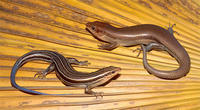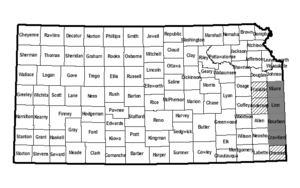BROADHEAD SKINK

Suzanne L. Collins, CNAH
This lizard has flat, smooth scales, five yellow stripes on back and sides, two yellow stripes on the head and the sixth scale back from the nose (upper lip) extending to the edge of the eye. As with the Five-lined Skink (E. fasciatus), this species exhibits different colors at various stages of adult life. Young adults are black with yellow stripes and have a bright blue tail. Older females are brownish, the yellow stripes may fade to brown or gray, and the blue tail becomes gray. Older males are uniform olive or tan, and lack stripes. Male Broadhead Skinks are larger than females and develop an orange-red head during breeding. Broadhead and Five-lined Skinks are extremely difficult to tell apart.
Broadhead Skinks prefer mature oak woodlands having dead and decaying timber where it depends on tree cavities, especially in standing dead trees, for nesting. Large deciduous trees, downed logs, rock outcrops and brushpiles in or near woodlands are also used as protective cover.

Broadhead Skinks are protected by the Kansas Nongame and Endangered Species Conservation Act and administrative regulations applicable thereto. Any time an eligible project is proposed that will impact the preferred habitats within the probable range of Broadhead Skinks, the project sponsor must contact the Ecological Services Section, Kansas Department of Wildlife, Parks and Tourism, 512 SE 25th Ave., Pratt, Kansas 67124-8174. Department personnel can then advise the project.
DESIGNATED CRITICAL HABITATSAs defined by Kansas Administrative Regulations, critical habitats include those areas documented as currently supporting self-sustaining populations(s) of any threatened or endangered species of wildlife as well as those areas determined by the Kansas Department of Wildlife, Parks and Tourism to be essential for the conservation of any threatened or endangered species of wildlife. Currently, the following areas are designated critical for Broadhead Skinks:
(1)All stands of mature oak woodland in Bourbon, Crawford, Linn, and Miami counties.
(2)Stands of suitable timber anywhere within the skink’s probable range may, upon field investigation, also be found to be essential for conservation of the species.







